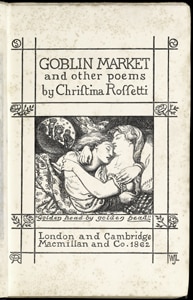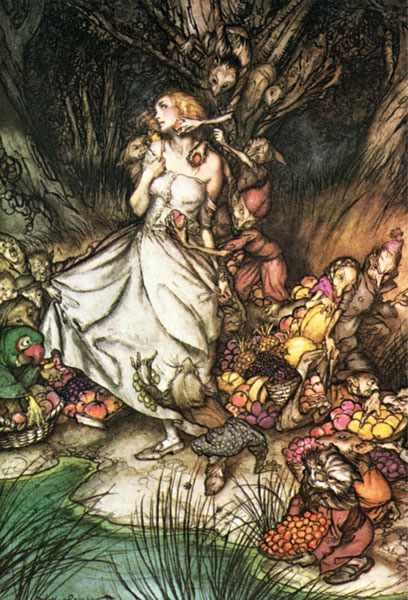Christina Rossetti’s poem, “Goblin Market”, is a tale about two young girls that are faced by goblin merchant men that are trying
to persuade and tempt them into partaking of their enchanted orchard fruits. One sister grows curious of the goblin’s strange produce while the other stays weary upon the memory of a friend named Jeanie that had died after eating the fruits.
While reading line by line, it is hard to miss the similarities between this work and the account of the fall of man in the bible. Rossetti takes the central themes of temptation, sin, and redemption from the bible and retells them in this complex twisted tale.
Laura and Lizzie, the main characters in the poem “Goblin Market”, can be seen being tempted many times throughout the work by the goblins. “Come buy our orchid fruits, come buy, come buy”(Rossetti 1496) they constantly called out, trying to persuade the girls. In Genesis 3, one can see the exact same scenario taking place.
Here we have Eve and Adam in the Garden of Eden, much like the orchard where the goblin men’s fruit is from as Rossetti describes. Eve is being tempted by the serpent, the adversary, to eat the forbidden fruit from the Tree of the Knowledge of Good and Evil. Laura is our Eve-type figure in the poem.
She is the one that hears the callings of the goblins and longs to taste their fruit. Both Eve and Laura give in to the temptations and do eat. This act of partaking in what was forbidden is their sin in both the account and the story.
In both cases of Genesis and “Goblin Market”, the women were told beforehand what was to happen if they sinned and ate what they were not supposed to. Genesis 2:16-17 says, “And Yahuah commanded the man, saying, “Of every tree of the garden you may freely eat; 17 but of the tree of the knowledge of good and evil you shall not eat, for in the day that you eat of it you shall surely die.” Likewise, Laura knew and was told the same thing.
Her sister says, “Do you not remember Jeanie, how she met them in the moonlight, took their gifts both choice and many,…[she] found them no more but dwindled and grew grey; then fell with the first snow, while to this day no grass will grow where she lies low”(Rossetti 1499). Both women were told that if they ate of the forbidden fruit that death was to come to them but neither of them listened.
Laura’s ‘death’ was to be a physical death of the flesh while Eve’s ‘death’ was to be more of a spiritual one and the loss of innocence, for not only her but for all of mankind afterward as well. On the bright side, however, there is a way in both stories for them to be saved. For salvation to occur, there must be a redeemer and redemption that takes place.
The redeemer of mankind in the bible is Yahusha the messiah (aka Jesus) and in “Goblin Market” it is Lizzie, Laura’s sister. Lizzie, who was tempted but did not give in to the naggings of the goblins, sacrificed herself in a way to save her sister from death, much like the Messiah.
We are told in the poem that after Lizzie encounters the goblins, despite their temptations, she stands strong and does not cave under the pressures asserted by them to eat. Angry, they attack her and though they “cuffed and caught her, coaxed and fought her, bullied and besought her…mauled and mocked her, Lizzie uttered not a word; Would not open lip from lip” (Rossetti 1505). By doing this and barring it as her stake/cross, Lizzie paid the price and redeemed the mistake or sin of her sister.
Lizzie tells Laura to “Make much of me: for your sake, I have braved the glen and had to do with goblin merchant men” (Rossetti 1506). Yahusha likewise bore his stake/cross and in doing so, made a way for all of mankind to be saved from their spiritual deaths. There is also a hint to the crown of thorns that Yahusha was forced to wear in “Goblin Market.
It says “One began to weave a crown of tendrils, leaves and rough nuts brown” (Rossetti 1498). If this is what Rossetti was alluding to, no one can know for sure.
Christina Rossetti’s poem “Goblin Market” is an outstanding merging of the central themes of temptation, sin, and redemption that are found throughout the midst of the bible.
The way she created her poem as a retelling of the account of the fall of man and their redemption is applauding. Similarities between the works cannot be missed for they stand out like bright stars in a clear night sky. If one does not see it, then they must not be looking.


